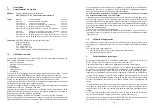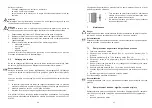
31
30
1 General
1.1
Identification of Model Version
Models:
Automatic Spray Guns
PILOT WA 705
- Serie without internal control
Types:
WA 705
(Standard-version)
V 20 705
WA 715-U
(Standard-circulation-version)
V 20 715
WA 725-HVLP
(Low pressure-version)
V 20 725
WA 735-HVLP-U
(Low pres.-circulation-version)
V 20 735
WA 745-HVLP
PLUS
(Mediem pressure-version)
V 20 745
WA 755-HVLP
PLUS
-U (Medium pres.-circulation-version) V 20 755
WA 708-K
(Standard-adhesive version)
V 20 708
WA 718-U-K
(Standard-circulation-adhesive-vers.) V 20 718
WA 728-HVLP-K
(Low pressure-adhesive version)
V 20 728
WA 738-HVLP-U-K (Low pres.-adhesive-circulation vers.) V 20 738
Manufacturer:
WALTHER Spritz- und Lackiersysteme GmbH
Kärntner Str. 18-30
D-42327 Wuppertal
Tel.: 0202 / 787-0
Fax: 0202 / 787-2217
www.walther-pilot.de • Email:[email protected]
1.2
Normal Use
The automatic spray guns of the series PILOT WA 705 are exclusively designed for
use with sprayable material types and grades such as:
•
paints and lacquers
•
greases, oils and corrosion preventives
•
adhesive compounds
•
Separating agent
•
ceramic glazes
•
pickling solutions
Should the materials which you want to spray not be listed above, please contact
WALTHER Spritz- und Lackiersysteme, Wuppertal for further and detailed informati-
on.
Please note that sprayable material may only be applied to work pieces and/or simi-
lar items. The temperature of the spraying materials shall never exceed 80 degrees
Celsius. The models of the series PILOT WA 7XX are not designed for manual ope-
ration, and must be installed in a suitable gun mounting device.
The term normal use also implies that any and all safety warnings, operational hand-
ling details, etc., as stated in these operating instructions, must be carefully read,
understood and duly complied with.
This equipment complies with the explosion protection requirements of Directive
2014/34/EU (ATEX) for the explosion group, equipment category and temperature
class indicated on the type plate.
When using the equipment, the requirements specified in these Operating Instructions
must be observed at all times.
The technical data indicated on the equipment rating plates and the specifications in
the chapter "Technical Data" must be complied with at all times and must not be
exceeded. An overloading of the equipment must be ruled out.
The equipment may be used in potentially explosive atmospheres only with the
authorisation of the relevant supervisory authority.
The relevant supervisory authority or the operator of the equipment are
responsible for determining the explosion hazard (zone classification).
The operator must check and ensure that all technical data and the marking of the
equipment in accordance with ATEX are compliant with the necessary requirements.
The operator must provide corresponding safety measures for all applications in
which the breakdown of the equipment might lead to danger to persons.
If any irregularities are observed while the equipment is in operation, the equipment
must be put out of operation immediately and WALTHER Spritz- und Lackiersysteme
must be consulted.
Grounding / Equipotential Bonding
You must ensure that the spray gun is properly earthed (grounded) either separately
or in connection with the equipment with which it is being used (maximum resistance
10
6
Ω).
1.3
Improper Use
This spray gun shall not be used for purposes other than set forth in the above
Chapter
1.2 Normal Use
. Any other form of use and/or application is prohibited.
Improper use is for example:
•
spraying of material onto persons and animals
•
spraying of liquid nitrogen, etc.
2
Technical Description
The models PILOT WA 705 are an all-automatic air-controlled guns operating in
combination with a 3/2-way control valve in the form of hand-, foot- or solenoid
actuated valves.
At first the atomizing air (round- and wide/flat jet air item 27) is openened by a 3/2-
way control valve. Then activate the control air that push back the piston and the
material needle to open the material supply.
For the models PILOT WA 7XX the spray jet contour (flat/wide/round) is adjusted by
a pressure regulator in the plant.
Closing of the 3/2-way valve is followed by the control air escaping from the cylinder
inside the gun, upon which the spring-loaded material needle returns to its initial
position, where it shuts the material and atomizing air input off.
The material flow volume is set with all models via the material pressure and by
limiting the orifice travel of the material needle on the cap (item 25).
The material flow of the automatic spray gun series PILOT WA 7XX can also be
opened by hand using the pulling rod (item 26) to clean, for example, a clogged
material nozzle. The spray guns of the PILOT WA 7XX series can be connected to
material pressure tanks and pumping systems.
















































